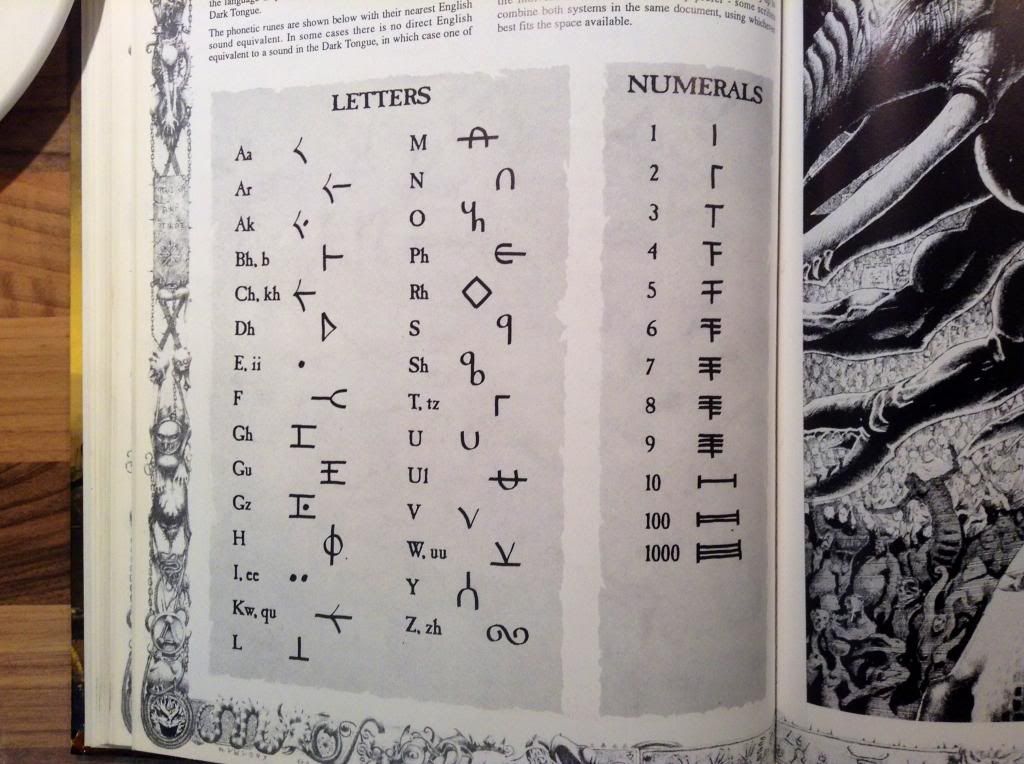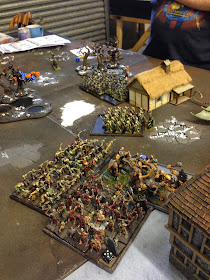 |
| Curtis's Tzeentch warband in all its glory. |
One of the more rewarding aspects of being a blogger is interacting with your readers. Its always a pleasure to read the emails you send me or the many Facebook messages. Occasionally, these discussions and communications are worth sharing with a wider audience - hence the creation of the 'On The Boil' articles I put on on this blog.
Today we hear from Curtis Fell, who is probably well known to many of you through the Facebook Community group. We got chatting at BOYL '14 and Curtis agreed to send through a missive concerning his recent endeavours with his gaming group. Now, I feel that was Curtis has to say is a perfect example of 'Oldhammer Gaming'. That its a mindset not a ruleset that defines us. I must admit that I did not feel this way in the early days, back then Oldhammer was for me playing Third Edition Warhammer with period Citadel miniatures. But I am not self obsessed or arrogant to suggest that 'my version' is any better or any worse than anyone else's 'version' of the Oldhammer experience.
Curtis has his own personal ideas of what he wants to achieve, and very much like the best of us, just gets on with the business of collecting, painting, interacting and playing to worry about writing long pseudo-intellectual wafflings. What follows is a really clear explanation about how Curtis' group used the rules they felt most appropriate, alongside the models they were keen to use, to create a positive outcome. It makes a jolly good read...
Orlygg
"When I got back to the UK about 8 months ago I wanted to play some games. Where I live in Nottingham is a really cool bunch of gamer guys. The ones I end up playing with are into old school gaming, most are mid 20s-30s and have been playing for 10 years or more. They also helped me playtest Nuclear Renaissance, so I think they are good and fun gamers. They do tend to lean towards the beardy in terms of power gaming, but in a really fun way. They do put the right models on the table, sometimes even finished! So the game we agreed to play was Realm of Chaos, using the Rogue Trader rules.
I always play Tzeentch so generated an appropriate champion and retinue. I got ridiculously good rolls! My champion started with a horrible 3 chaos attributes, but they all rolled up amazing profiles. Chaos Lord is obviously an awesome mutation. I got a nice suit of mithril as the magical item Tzeentch champions get. However, the headless attribute means you can't wear armour. So a powerful character but with a cool weakness: no armour allowed!
 |
| Beautiful painting on these beastmen figures. |
I think I then rolled some Dark Elves, some Beastmen and a Hydra, so that was the initial warband. The troll came later as did the harpies. I still have the 5 Dwarves to finish.
I guess I should step in with a bit of an exposition on house rules at this point.We allow any roll on the retinue table to be swapped for a roll on the Universal creatures table (my second favourite table, after the mutations!). One guy rolled up dragon on the list, I got a Hydra, but you usually end up with a low level human.
We were playing warbands using Rogue Trader (RT), and the equipment chart and rules are a bit ropey to say the least. We agreed to only allow assault cannons on terminator armour, as they are beastly wepons.
 |
| The champion model is an imaginative conversion. This figures need to be unique, though use of vintage Citadel is not a non-negotiable. |
Vortex Grenades were out, but we agreed that once a grenade was bought, your character kept it for the entire campaign. Grenades are a paint to use anyway, but have really fun results. The toxin and virus grenades being the most deadly. We fiddled a bit with the rules on saves vs virus and toxin. In the rules you get basically no save against them, and no roll to wound, so we gave breathing masks a save and sealed suits a better one. We also over turned the rule that jump packers could drop grenades willy nilly. Also the blind grenades meant you had to invest in photo visors and such like!
We allowed players sell equipment that thier followers have and buy new stuff. We started by letting players sell the items on the fantasy table, then buy new equipment on the sci-fi table, but this quickly degenerated into the idea that you could buy anything from either table. In RT armour stacks, so mesh and flack is fine for a 4+ save. But then we allowed it to stack with plate, chain, power and shields. Ridiculous, but when one of the other champions was wielding a deamon sword with a deamon prince in also wielding a deamon sword with a deamon prince in also wielding a deamon sword with a deamon prince in or virus grenades you start to not worry about a minus 3 or up save....
 |
| Dark Elves - or Dark Eldar I suppose! |
The models I managed to scrouge up were a bunch of Lord of the Rings plastics, necron arms, a heavy bolter, back packs and bits of plasticard and house hold detritus. The disk is a washer.
The champion is an Ubashi I think from the tomb kings range. I cut off his head as the champ has the headless mutation. I used the head as his las pistol (lazer eyes!). Its a cool model, I just had to sculpt the hand.
The Hydra is an incomplete tyranid carnifex. I sculpted the tentacles, saggy bits and a strange human mouth to be suitably Tzeenchian.
The troll is totally scratch built. I didnt get a good photos of his back, but he has a grafted on frenzon dispenser, which the champion has a remote control for. This means he is no longer subject to stupidity as he is frenzied all the time! Hurrah for the future when we no longer have to suffer the inane whims of stupid trolls!
 |
| Scratch-built Disc of Tzeentch |
The harpies were the most fun to do. My friend Lex is a jeweler, but also plays alot of board and card games, so is quite into models without actually wanting to do it as a hobby. So I gave her a bunch of bits, some putty , sprue and a sculpting too and persuaded to get her to make one. I then used equivelent bits and made my own version (mine is the one with the jump pack, hers the wings). I love her model as its coming from a person who is really talented at small sculpting work, yet never tries to make odd, figurative fantasy models from the 80s! What a cool result I think, and fits in with my totally strange warband.
I want to again stress that I was just moving and so my model making kit was stored or in transit. I had to beg up the models off the gaming group and then buy the cheapest paints and brushes to do the job. I live near a large Hobby craft, and so bought their cheap acrylic. I bought black, white, yellow, very dark blue, day glow pink, day glow blue and a light gold. There were awful paints! They really lacked pigment, so were really thin and watery. The metallic was the worst of the lot, containing very little actual metal pigment! I also got a pack of cheap brushes. They are great! About £3 for a set of 3. They hold thier point well and are just the right softness.
 |
| Beautifully modelled harpies. Outstanding, don't you think? |
I had to work out a method of painting that would work on the miniatures, while still being in the style of figure painting, but with really strange paints. What I ended up doing was drybrushing the bare models white. THe champion was already undercoated in black, so the white went over that. Most of the other models were grey plastic or grey putty (ProCreate). I also used a tooth brush to start building texture at this stage. I flicked on some white.
When this was dry, I then went onto using the pigment-poor paint as a glaze to colour the gray to white tone I put on in the first stage. A glaze is a bit like a wash, but you try to get the paint to spread evenly and thinly. This stains the area in your glaze colour. After this I applied more white, and again another layer of colour glaze. I also painted on several layers of the metal colour on the metal areas. Again, this shows the white through, so gives tonal range.
 |
| A gruesome hydra! |
After this stage, I went a bit crazy with the tooth brush, splattering everything in pink and blue splatters. Great fun and adds a weird other world texture. When dry I carefully painted in all the lining and shadows with the dark blue.
The final stage was a pass with the white highlights again and paint in all the details.
The campaign didnt last for a huge amount of time, maybe a couple of months. However, towards the end there was a huge disparity between the warbands, with some being really weak and others (like mine) very powerful. However, I think the game still works. I played alot of warbands when it initially came out, so have been playing it for many years. To play a game means to have a fun time, and I want to field this warband in a ways that make it fun for my opponents. An easy way to do this is to only go into games with a part of my force. Another way is to play games where there is an objective that weight of numbers or hitting power does not factor in.I intend to continue with this warband for the foreseeable future. I'm well up for some 40k realm of chaos if anyone wants to have a go!"
 |
| A troll! |
Curtis Fell















































